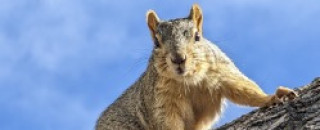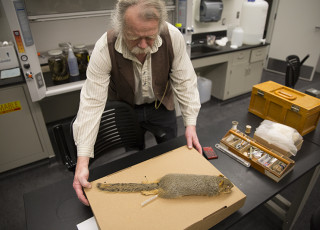NHMU Asks the Public to check “Yes” or “No” to Squirrels Living in Your Neighborhood
Salt Lake City, Dec. 2, 2022 – Calling all nature photographers and Citizen Scientists! Let your time on the slopes or the streets this week serve science! It's Squirrel Fest, and all you need to participate is your phone! The Natural History Museum of Utah (NHMU) hosts its third annual weeklong Squirrel Fest Dec. 3–11, 2022. The festival encourages the community to contribute observational data about squirrels – which is as easy as snapping a photo.
The mission of Squirrel Fest is of grand importance to the NHMU: to rally Utahns as Citizen Scientists to help track the distribution of squirrels in the state. And it’s EASY! When you’re out looking for squirrels, report your findings and add your photos to NHMU’s squirrel survey form!
You’ll be letting researchers know where they live, where they don’t live, and what they’re up to!
Led by Eric Rickart, NHMU’s curator of vertebrates, and Ellen Eiriksson, the museum’s Citizen Science program manager, Squirrel Fest is doing what the American Audubon Society’s Christmas Bird Count has done for more than 100 years across the nation. This is critical long-term data that helps biologists can better track animal population distribution and trajectory. In this case, NHMU is tracking Utah’s squirrels with smartphones, so it’s easy and effective.
By filling out a Fox Squirrel Survey form on NHMU’s website, anyone can record squirrel observations to help biologists like Rickart follow the spread of species and better understand their impacts on our environment. The relevant example here is the fox squirrel, which was introduced to Utah around 2010 and has spread rapidly—especially in the urban landscape of Salt Lake City.
“The fox squirrel data has allowed us to study how a non-native species becomes established in a new environment. In six years, fox squirrels have increased their range along the Wasatch Front and continue to adapt to the urban environment,” Rickart said.
“There is no way that the museum would be able to collect this amount of data without many observers around the state,” said Eiriksson. “People are continually submitting quality, in-depth descriptions of squirrel behavior. It’s wonderful to see such enthusiasm from our community and we want participants to know that their contributions of everyday squirrel observations are of great help to NHMU's ongoing research in the natural world.”
In 2021, Citizen Scientists who participated in Squirrel Fest contributed more than 450 observations of Northern Utah’s squirrels, and how they interacted with the ecosystem. This combined data becomes a valuable part of Rickart’s research. In his 30 years of studying mammals, the seasoned biologist believes Citizen Science contributions—in efforts like Squirrel Fest—are collectively one of the most valuable tools at his disposal.
The number and quality of observations NHMU has received clearly emphasizes the public’s fascination with these charismatic critters that share our backyards and neighborhoods. Both Rickart and Eiriksson hope to continue recruiting Citizen Scientists through events like Squirrel Fest.
To participate in Squirrel Fest this year, just visit https://nhmu.utah.edu/squirrels to find the survey and you’re ready to go! You can also learn more about Utah’s squirrels and all of NHMU’s Citizen Science projects. And don’t miss Rickart and Eiriksson at our Squirrel Fest outreach event happening on Saturday Dec. 3 at Veteran’s Memorial Park in West Jordan. The first 100 Citizen Scientists to submit a survey during Squirrel Fest will receive a free thank you gift for participating.
###
Press contacts and links
-
Press Contact
Beth Mitchell

